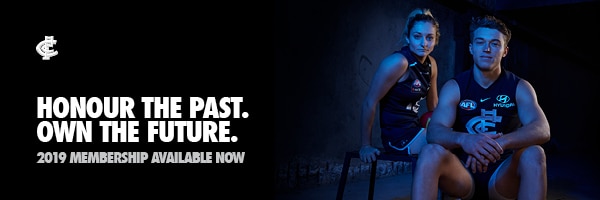THE AFL has released the rules for the upcoming AFLX tournament to be held on Friday 22 February at Marvel Stadium.
AFLX 2019 will be played on a rectangular field 110m long, and aims to showcase the unique and most thrilling aspects of Australian football.
Four teams will compete in a round-robin format, with the Grand Final to be held between the top two teams.
Carlton’s very own Patrick Cripps was named as the vice-captain of Jack Riewoldt’s team, the appropriately-named RAMPAGE.
The young superstar shared his excitement to play alongside Riewoldt and other superstars of the competition, believing it will be a great showcase of talent and skill.
“When he’s not singing Mr Brightside, Jack is a superhero of our game and I’m thrilled to help him lead team RAMPAGE,” Cripps said.
“With the rest of the team still to be named, I know it’s going to be fierce come February 22.”
The remaining players will be selected at this Wednesday’s AFLX draft. It is yet to be confirmed whether any other Carlton players will feature in the tournament.
AFLX will be played on a 110m rectangular field, and consist of two ten minute halves.
The following rules will come into play for the AFLX 2019 tournament.
Number of players
14 players per team; 8 on the field, 6 on the interchange bench (no interchange limit).
Centre ball-up and starting positions
The field umpire shall throw up the football to commence play at the beginning of each half and after a 10-point goal has been scored.
Two players from each team must start inside the 15-metre zone at each end.
Disposal – From out of bounds
A player who is awarded a free kick from outside the field may bring the football into play by either moving across the boundary line, kicking or handballing the ball back into play. The player must take the free kick from outside the line from the point where the ball went out of bounds or the point the ball goes over the end-line.
Bouncing the football
A player in possession of the football must bounce or touch the football on the ground at least once every 20 metres.
Backwards kicks
Players will not be awarded marks for backwards kicks except in the forward 15m zone.
25m penalty
25m penalty instead of 50m for infringements as per laws of the game.
Scoring
A six-point goal is scored when the football is kicked completely over the goal line by a Player of the attacking team without being touched by any other player
A 10-point goal (Super Goal) is scored in the following instances:
- When the football is kicked by a player of the attacking team from anywhere within or behind the launch zone and passes completely over the goal line without being touched by any other player.
- When the football is kicked by a player of the attacking team from anywhere within or behind the Launch Zone and is marked within the 15-metre forward zone by a player of the attacking team who then scores a goal.
Goal umpires will signal a Super Goal by putting both hands above their head with arms fully extended and hands facing forward. If a 25m penalty brings the player forward of the launch zone the shot on goal will be awarded as a Super Goal.
Set shot timing
Where a player is kicking for a six-point goal or a 10-point goal after being awarded a mark or a free kick, the kick shall be taken within 10 seconds.
Kicking the football into play after a six-point goal or behind has been scored
- After a six-point goal or behind has been scored, a team has 10 seconds – once they collect a football – to kick the ball in and re-start play.
- The kick can be taken from anywhere between the point posts after the goal umpire has signalled a behind, or a six-point goal. The kick must be taken from behind the line.
- To play on, the player can run across the line from outside the end line into the field of play.
- The umpire is to bring the player on the mark back 5m to ensure the player taking the kick has enough space to do so.
Deliberate rushed behinds
- A free kick shall be awarded against a player from the defending team who intentionally kicks, handballs or forces the football over the attacking team’s goal line or behind line or onto one of the attacking team’s goal posts. The players intention is the key criteria when assessing whether a free kick should be awarded.
- Deliberate rushed behinds (by a defending team) count as one point and the attacking team also receive the ball back with a free kick 15m out directly in front with the man on the mark placed on the line. The player closest to the rushed behind will be awarded the kick and they are able to have a 10-point shot on goal.




